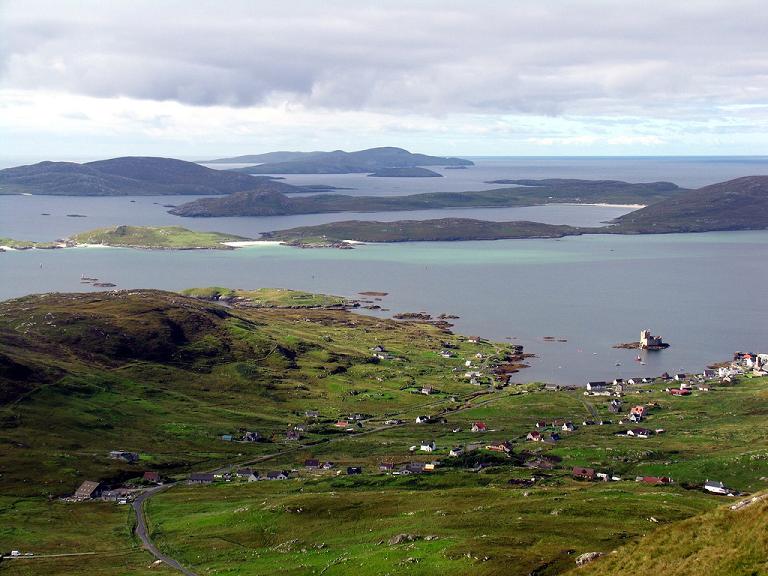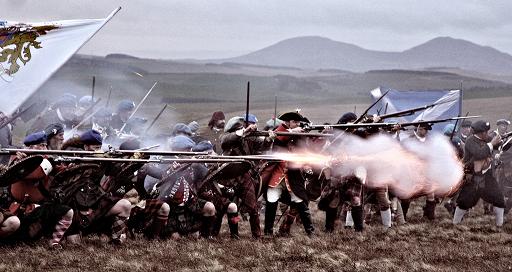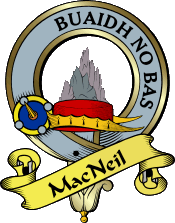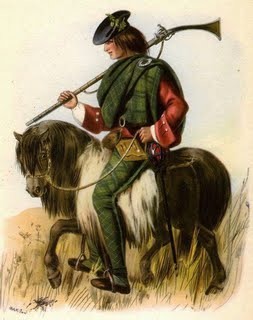The MacNeil's consisted of two independent branches, the MacNeil's of Barra and the McNeill's of Gigha, said to be descended from brothers. Their badge was the sea ware, but they had different armorial bearings, and from their circumstances, joined to the fact that they were often opposed to each other in the clan fights of the period, and that the Christian names of the one, with the exception of Neill, were not used by the other, Mr Gregory thinks the tradition of their common descent erroneous. Part of their possessions were completely separated, and situated at a considerable distance from the rest.
The clan Neill were among the secondary vassal tribes of the lords of the Isles, and its heads appear to have been of Norse or Danish origin. Mr. Smibert thinks this probable from the fact that the McNeill's were lords of Castle Swen (or Sween), plainly a Norse term. "The clan", he says, "was in any case largely Gaelic, to a certainty. We speak of the fundamental line of the chiefs mainly, when we say that the McNeills appear to have at least shared the blood of the old Scandinavian inhabitants of the western islands. The names of those of the race first found in history are partly indicative of such a lineage. The Isle of Barra and certain lands of Uist were chartered to a MacNeill in 1427; and in 1472, a charter of the MacDonald family is witnessed by Hector Mactorquil Macneill, keeper of Castle Swen. The appellation 'Mac-Torquil', half Gaelic, half Norse, speaks strongly in favor of the supposition that the two races were at this very time in the act of blending with one people. After all, we proceed not beyond the conclusion, that, by heirs male or heirs female, the founders of the house possessed a sprinkling of the blood of the ancient Norwegian occupants of the western isles and coasts, interfused with that of the native Gael of Albyn, and also of the Celtic blood, beyonf doubt, is far the largest in the veins of the clan generally".
About the beginning of the 15th century, the McNeills were a considerable clan in Knapdale, Argyllshire. As this district was not then included in the sheriffdom of Argyll, it is probable that their ancestor had consented to hold his lands of the crown.

The first of the family on record is Nigellus Og, who obtained from Robert Bruce a charter of Barra and some lands in Kintyre. His great-grandson, Gilleonan Roderick Muchard Macneill, in 1427, received from Alexander, Lord of the Isles, a charter of that island. In the same charter were included the lands of Boisdale in South Uist, which lies about eight miles distant from Barra. With John Garve Maclean he disputed the possession of that island, and was killed by him in Coll. His grandson, Gilleonan, took part with John, the old Lord of the Isles, against his turbulent son, Angus, and fought on his side at the battle of Bloody Bay. He was chief of this sept or division of the Macneills in 1493, at the forfeiture of the lordship of the Isles.
The Gigha McNeill's are supposed to have sprung from Torquil Macneill, designated in his charter, "filius Nigelli", who, in the early part of the 15th century, received from the Lord of the Isles a charter of the lands of Gigha and Taynish, with the constabulary of Castle Sweyn, in Knapdale. He had two sons, Neill his heir, and Hector, ancestor of the family of Taynish. Malcolm McNeill of Gigha, the son of Neill, who is first mentioned in 1478, was chief of this sept of the McNeill's in 1493. After that period the Gigha branch followed the banner of Macdonald of Islay and Kintyre, while the Barra MacNeil's ranged themselves under that of Maclean of Dowart (or MacLean's of Duart).
In 1545 Gilliganan Macneill of Barra was one of the barons and council of the Isles who accompanied Donald Dubh, styling himself Lord of the Isles and Earl of Ross, to Ireland, to swear allegiance to the king of England. His elder son, Roderick or Ruari Macnell, was killed at the battle of Glenlivet, by a shot from a fieldpiece, on 3rd Oct. 1594. He left three sons - Roderick, his heir, called Ruari the turbulent, John and Murdo. During the memorable and most disastrous feud which happened between the MacLeans and the MacDonalds at this period, the Barra MacNeil's and the Gigha branch of the same clan fought on different sides.
The MacNeil's of Barra were expert seamen, and did not scruple to act as pirates upon occasion. An English ship having been seized off the island of Barra by Ruari the turbulent, Queen Elizabeth complained of this act of piracy. The Laird (Scottish Lord) of Barra was in consequence summoned to appear at Edinburgh, to answer for his conduct, but he treated the summons with contempt. All the attempts made to apprehend him proved unsuccessful. Mackenzie, "Tutor of Kintail", undertook to effect his capture by a stratagem frequently put in practice against the island chiefs when suspecting no hostile design. Under the pretense of a friendly visit, he arrived at Macneill's castle of Chisamul (or Kisimul), the ruins of which stand on an insulated rock in Castlebay (ontop of an old Viking keep), on the south-east end of Barra, and invited him and all his attendants on board his vessel. There they were well plied with liquor, until they were all overpowered with it. The chief's followers were then sent on shore, while he himself was carried a prisoner to Edinburgh. Being put upon trial, he confessed his seizure of the English ship, but pleaded in excuse that he thought himself bound by his loyalty to avenge, by every means in his power, the fate of his majesty's mother, so cruelly put to death by the queen of England. This polite answer procured his pardon, but his estate was forfeited, and given to the "Tutor of Kintail". The latter restored it to its owner, on condition of his holding it for him, and paying him sixty merks Scots (a merk is a Scottish silver coin originally valued at 13 shillings and 4 pence {exactly ⅔ of a pound Scots, or about one shilling in English coin}, later raised to 14s Scots.), as a yearly feu-duty (rent). It had previously been held of the crown. Some time thereafter Sir James MacDonald of Sleat married a daughter of the Tutor of Kintail, who made over the superiority to his son-in-law, and it is now possessed by Lord Macdonald, the representative of the house of Sleat.
The old chief of Barra, Ruaru the Turbulent, had several sons by a lady of the family of MacLean, with whom, according to an ancient practice in the Highlands, he had handfasted (handfasting was an ancient custom in the Isles that a man take a maid as his wife and keep her for the space of a year without marrying her; and if she pleased him all the while, he married her at the end of the year and legitimized her children; but if he did not love her, he returned her to her parents), instead of marrying her. He afterwards married a sister of the Captain of the Clanranald, and by her also he had sons. To exclude the senior family from the succession, the Captain of the Clanranald took the part of his nephews, whom he declared to be the only legitimate sons of the Barra chief. Having apprehended the eldest son of the first family for having been concerned in the piratical seizure of a ship of Bourdeaux, he conveyed him to Edinburgh for trial, but he died there soon after. His brothers-german (full brothers), in revenge, assisted by Maclean of Dowart, seized Neill Macneillm the eldest son of the second family, and sent him to Edinburgh, to be tried as an actor in the piracy of the same Bourdeaux ship; and, thinking that their father was too partial to their half brothers, they also seized the old chief, and placed him in irons. Neill Macneill, called Weyislache, was found innocent, and liberated through the influence of his uncle. Barra's elder sons, on being charged to exhibit their father before the privy council, refused, on which they were proclaimed rebels, and commission was given to the Captain of the Clanranald against them. In consequence of these proceedings, which occurred about 1613, Clanranald was enabled to secure the peaceable succession of his nephew to the estate of Barra, on the death of his father, which happened soon after.
The island of Barra and adjacent isles are still possessed by the descendant and representative of the family of MacNeil. Their feudal castle of Kisimul has already been mentioned above. It is a building of hexagonal form, strongly built, with a wall above thirty feet high, and anchorage for small vessels on every side of it. Martin, who visited Barra in 1703, in his Description of the Western Isles, says that the Highland Chroniclers or sennachies alleged that the then chief of Barra was the 34th lineal descendant from the first MacNeil who had held it. He relates that the inhabitants of this and the other islands belonging to MacNeil were in the custom of applying to him for wives and husbands, when he named the persons most suitable for them, and ave them a bottle of strong waters for the marriage feast.
The chief of the McNeill's of Gigha, in the first half of the 16th century, was Neill Macneill, who was killed, with many gentlemen of his tribe in 1530, in a feud with Allan MacLean of Torlusk, called Ailen nan Sop, brother of MacLean of Duart (or Dowart). His only daughter, Annabella, made over the lands of Gigha to her natural brother, Neill. He sold Gigha to James MacDonald of Islay in 1554, and died without legitimate issue in the latter part of the reign of Queen Mary.
On the extinction of the direct male line, Neill Macneill vic Eachan, who had obtained the lands of Taynish, became heir male of the family. His descendant, Hector Macneill of Taynish, purchased in 1590 the island of Gigha from John Campbell of Calder, who had acquired it from MacDonald of Islay, so that it again became the property of a McNeill. The estates of Gigha and Taynish were possessed by his descendants till 1780, when the former was sold to McNeill of Colonsay, a cadet of the family.
The representative of the male line of the McNeill's of Taynish and Gigha, Roger Hamilton Macneill of Taynish, married Elizabeth, daughter and heiress of Hamilton Price Esq, of Raploch, Lanarkshire, with whom he got that estate, and assumed, in consequence, the name of Hamilton. His descendants are now designated of Raploch.
The principal cadets of the Gigha McNeill's, besides the Taynish family, were those of Gallochallie, Carskeay, and Tirfergus. Torquil, a younger son of Laclan Macneill Buidhe of Tirfergus, acquired the estate of Ugadale in Argyllshire, by marriage with the heiress of the MacKay's in the end of the 17th century. The present proprietor spells his name Macneal. From Malcolm Beg Macneil, celebrated in Highland tradition for his extraordinary prowess and great strength, son of John Oig Macneil of Gallochallie, in the reign of James VI, sprung the Macneils of Arichonon. Malcolm's only son, Neill Oig, had two sons, Hohn, who succeeded him, and Donald Macneil of Crerar, ancestor of the McNeill's of Colonsay, now the possessors of Gigha. Many cadets of the McNeill's of Gigha settled in the north of Ireland.
Both branches of the clan Neill laid claim to the chiefship. According to tradition, it has belonged, since the middle of the 16th century, to the house of Barra. Under the date of 1550, a letter appears in the register of the privy council, addressed to "Torkill Macneil, chief and principal of the clan and surname of Macnelis". Mr Skene conjectures this Torkill to have been the hereditary keeper of Castle Sweyn, and connected with neither branch of the Macneils. He is said, however, to have been the brother of Neil Macneil of Gigha, killed in 1530, as above mentioned, and to have, on his brother's death, obtained a grant of the non-entries of Gigha as representative of the family. If this be correct, according to the above designation, the chiefship was in the Gigha line. Torquil appears to have died without leaving any direct succession.
The first of the family of Colonsay, Donald Macneill of Crerar, in South Knapdale, exchanged that estate in 1700, with the Duke of Argyll, for the islands of Colonsay and Oronsay. The old possessors of these two islands, which are only separated by a narrow sound, dry at low water, were the MacDuffie's, or MacPhie's. Donald's great-grandson, Archibald MacNeill of Colonsay, sold that island to his cousin, John MacNeill of Dunmore, and had six sons. His eldest son, Alexander, younger of Colonsay, became the purchaser of Gigha. Two of his other sons, Duncan, Lord Colonsay, and Sir John McNeill, have distinguished themselves, the one as a lawyer and judge, and the other as a diplomatist.

The MacNeil's were Jacobites, and as such were at the center of both Jacobite uprisings. In 1689, the 38th Chief, Roderick Dhu (The Black), led the MacNeil Clan into battle for James VII at Killiecrankie. He remained loyal to the cause and rallied to the 'Old Pretender' at the rising of 1715. His 2 sons, Roderick and James, went into exile in France. They returned upon their fathers death.
In 1745, the Clan was rallied again with a Spanish ship landing arms and money on Barra for the army of the Prince. After the second rebellion, British troops landed on Barra in their search for Charles Edward Stuart (Bonnie Prince Charlie). In 1746 The 39th Chief, Roderick Dove of the West (not to be confused with the 40th Chief Roderick the Gentle or the 41st Chief, Roderick the General) was arrested and taken to London. For his Jacobite sympathies, Roderick was consigned to a prison ship, the Royal Sovereign. It was not until 1747 that his discharge was ordered and he was free to return home. Luckily for Roderick, his estates were not forfeited.
In 1838 due to financial hardship caused by the collapse of the kelp industry (and, some say, a gambling problem) the 41st Chief, General Roderick MacNeil, was forced to sell the island, and in so doing lost what the former Chief Roderick had fought so hard to keep. Thus eight hundred years of direct MacNeil rule came to an end. Roderick also left no children, and the Chiefship passed to a cousin who had emigrated to the New World. The end of MacNeil rule coincided with the time when the Clearances began, and the people of Barra, and countless MacNeil's, were forced to emigrate to the Americas.
Many MacNeil's ended up in Canada. To this day, a large number of MacNeil's can be found in Nova Scotia and other Maritime provinces. As well, MacNeil's are found throughout the rest of Canada and the United States.
In 1937 most of Barra and Kisimul was purchased by Robert Lister Macneil, a descendant of the 42nd Chief, and an American citizen. After almost one hundred years, Barra was back in the hands of the MacNeil's. Robert Lister Macneil spent the rest of his life restoring Kisimul Castle. His grandson, Roderick "Rory" Wilson Macneil, Baron of Barra, is now the 47th Chief of Clan MacNeil.

